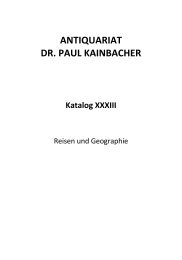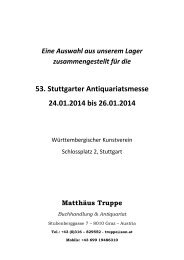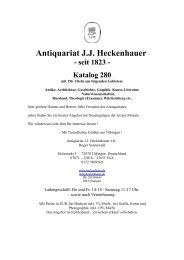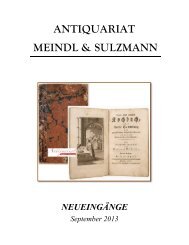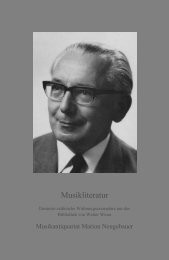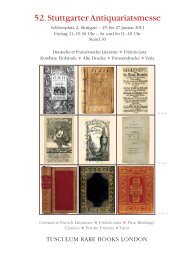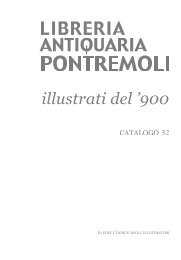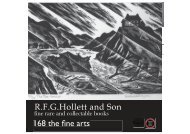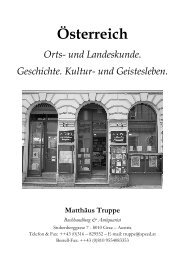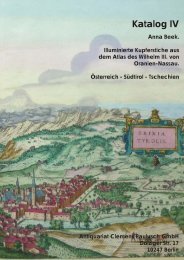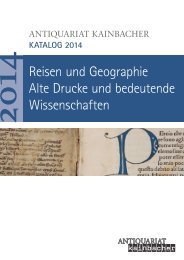Japanese Prints
Japanese Prints
Japanese Prints
Create successful ePaper yourself
Turn your PDF publications into a flip-book with our unique Google optimized e-Paper software.
Henry Sotheran Limited 67<br />
was ‘one of the finest products of the Jesuits in Japan’ (r.J.<br />
Howgego encyclopaedia of exploration to 1800 (potts point, nSW:<br />
2003), p. 900); this remarkable work contains a grammar and guide<br />
to pronounciation, a treatise on <strong>Japanese</strong> literature and a guide to<br />
literary style, together with practical advice on the culture and<br />
society of Japan, and was followed by the Arte breve da lingoa<br />
iapoa (Macao: 1620). rodrigues’s letter for the year 1606 was first<br />
published in Italian in rome by Bartolomeo Zannetti in 1610, and<br />
gives an overview of events in 1606, discussing the death of<br />
Allessandro Valignano, the superior of the mission to the East, at<br />
Macao in 1606, the progress of colleges and residencies, and<br />
political matters. following the rise to power of Ieyasu, who<br />
appointed rodrigues his personal commercial agent at nagasaki in<br />
1601, the Jesuits felt that their fortunes were improving, and the<br />
number of converts appears to have increased enormously, from<br />
300,000 in 1600 to 750,000 in 1606 (cf. Lach and van Kley, III, p.<br />
172); however, 1606 saw greater restrictions on proselytising, with<br />
the warning that only <strong>Japanese</strong> of the non-noble classes could be<br />
converted, and a gradual increase of anti-christian feeling, which<br />
culminated in the ‘Great persecution’, shortly after rodrigues’s<br />
departure from Japan for china in 1610.<br />
The second letter printed here is from the celebrated Jesuit sinologist<br />
Matteo ricci (1552-1610), and was first published in Italian in<br />
rome in 1610 by Zannetti. ricci studied in rome, before travelling<br />
to Goa in 1578, where, apart from a period at cochin, he remained<br />
until he travelled to china via Macao in 1582. ricci, together with<br />
Michele de ruggieri and other missionaries, gradually penetrated<br />
further into mainland china and established residences at<br />
chaoch’ing in 1583 and Shaochow in 1589. from 1589, at the latter<br />
residence, ricci adopted the dress of an educated chinese and, due<br />
to his proficiency with Mandarin, dispensed with the services of<br />
interpreters. despite various setbacks, ricci’s knowledge of the<br />
sciences, astronomy, and geography became appreciated by the<br />
authorities, and in 1600 ricci was invited to enter peking by<br />
Emperor Wan-li. ricci arrived in the city in 1601, and a residence<br />
was established there in 1606, where ricci was based until his death<br />
in 1610. during this period he translated a number of works into<br />
chinese (including the first six books of Euclid), which both<br />
enhanced his reputation in cultivated chinese circles and served to<br />
propagate christian theology; however, his reputation stems<br />
principally from his letters and his journal, which was posthumously<br />
published under the title De christiana expeditione apud Sinas<br />
(Augsburg: 1615), edited by the Jesuit nicolas Trigault, who<br />
brought the manuscript back from china to Europe. This work<br />
‘became the most influential description of china to appear during<br />
the first half of the seventeenth century [... and] provided European<br />
readers with more, better organized, and more accurate information<br />
about china than was ever before available’ (Lach and van Kley,<br />
III, pp. 512-513). ricci’s ‘Litterae chinenses’ published here follow<br />
the traditional format, and recount the mission’s activities in sections<br />
relating events at the residences of Shaochow (established in 1589),<br />
nanch’ang (1595), nanking (1599), and peking.<br />
This first Latin edition of these two important accounts — in the<br />
language through which they would become best known — is<br />
rare on the market, and no other copy can be traced in ABpc<br />
since 1975. This copy is particularly remarkable for its<br />
provenance: it was previously in the collection of the plantin-<br />
Moretus family, and was retained by them as a duplicate,<br />
following the sale of the family collections and property to the<br />
city of Antwerp in 1876 by Jonker Edward Moretus; it therefore<br />
seems most probable that this is the original binding.<br />
Cordier, Japonica col. 257; Cordier, Sinica col. 806; le Pagès<br />
‘Supplément’ p. 26; Simoni, low Countries 1601-1621, r-89 (noting<br />
2 copies in the Bl, one lacking final leaf); Sommervogel i, col. 447.<br />
293<br />
293. SARGENT, W. R. The copeland collection. chinese<br />
and <strong>Japanese</strong> ceramic figures. Massachusetts: Peabody<br />
Museum of Salem, [1991]. £35<br />
4to. Original cloth in dustwrapper; pp. 287; numerous colour<br />
illustrations from photographs; as new.




